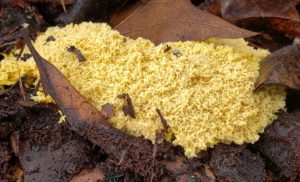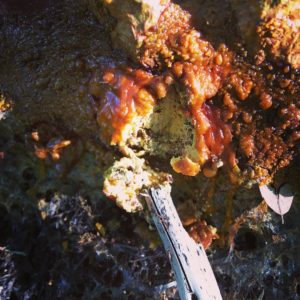Are you seeing a lot of odd looking blobs of yellow, pink, white, or even orange looking foam substance?

Slim mold growing on compost
You are not alone. And no it’s not some animal vomiting, this is Slim Mold.
Slime molds belong in the phylum Myxomycota in the kingdom Protista. They are not a true fungus. These organisms exist in nature as a “blob” (plasmodium), similar to a amoeba. And they engulf their food, mostly bacteria. The slime mold that typically appear on mulches are from the genus, Fuligo septica .

Slim mold growing from an office worm bin.
The brightly color blobs usually appear and may spread around mulched beds when there is high humidity and relatively warm temperatures. In Texas, we typically hear of slime molds in the spring and occasionally in the summer in highly irrigated shade areas. Slime mold can appear to be bright yellow to red. As they begin to dry out, these colors fade to brown and tan. Breaking up the dried blob, you may notice a dark brown to black core – the spores. Slime molds are not known to be a danger to human or animals.
 Chemical treatment is not warranted for this problem. These organisms are very sensitive to the environment. The best approach to controlling slime mold is by modifying the environment. Slime molds do not survive well in dry conditions.
Chemical treatment is not warranted for this problem. These organisms are very sensitive to the environment. The best approach to controlling slime mold is by modifying the environment. Slime molds do not survive well in dry conditions.
While we cannot control the spring rains, you can carefully manage your irrigation systems to reduce the amount of wetness on the surface. You can also use a rake or even use a stream of water to break up the slime mold. This will encourage the drying out of the slime mold and remove the unsightly “vomit”.
Some people consider the slime mold to be a beneficial organism in that it helps in the decaying process of the mulch and may also play a role in competing against some soilborne plant pathogens. However, most will find this an unsightly mess.
Check out this short video from the Texas Plant Disease Diagnostic Laboratory (TPDDL) it has great information you can share with others. You can also visit their website at http://plantclinic.tamu.edu
https://www.facebook.com/TXPlantClinic/videos/10156592384627558/
Thank you to Dr. Kevin Ong, PhD, Professor & Associate Department Head, Extension Program, Department of Plant Pathology & Microbiology and Director of TPDDL for sharing this information with me. Everytime I see this particular mold I think of Dr. Ong when he first started with AgriLife Extension and was stationed at the Dallas Center. The facts about this mold has not changed from 2005 to now, with lots of moisture comes a growth that thrives with warm temps and lots of water.
Finally, I found this article from the Northwest Extension District, UF/IFAS Gardening page they had slim mold grow out of their vermi composting bins https://nwdistrict.ifas.ufl.edu/hort/tag/edible-slime-mold/ something teachers might need to consider as well.

 .
.